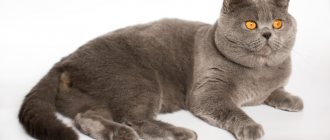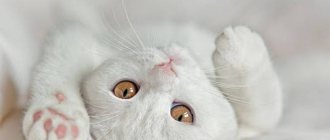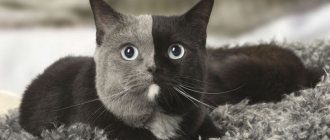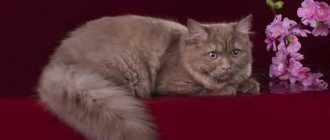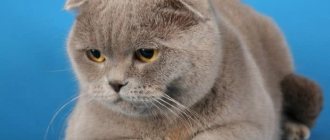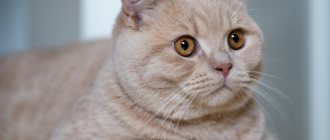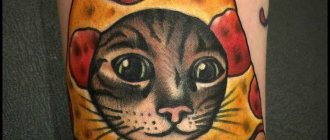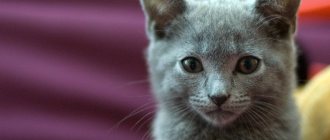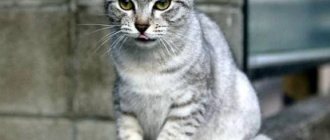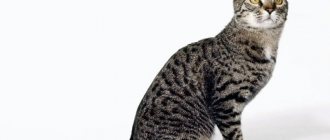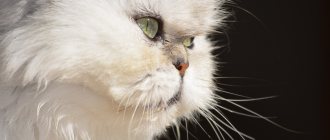Peculiarities
The term tabby is usually used to describe patterned colors.
Tabby kittens look very unusual. Several different cat breeds have tabby colors, including British cats. This breed is distinguished by a huge number of different colors. There will never be two identical representatives of the breed, each is unique.
If there is a cat of this breed in the house, in any case the question will arise about the origin of the pet and its color. The symmetrical spots on the coat have clear lines with a distinctive contrasting pattern. The ancestors who passed on this coloring to today's cats lived in the wild in India, Kazakhstan and Africa.
Character
When you look at a white British man, you have an uncontrollable desire to cuddle him. However, the animal itself does not tolerate familiarity. Although kittens do not refuse to play and caress with their owner. Adults do not like to be held. If you pet a British cat while sleeping or when she is busy doing something, the animal will most likely leave or show sharp claws. The owner can only resign himself and caress the pet with his eyes.
The fluffiest cat breeds
Smart cats: breed rating
Fold cat breeds
Owners of white British cats often admit that they do not feel like their owners. This does not mean that animals do not need care and love. They crave attention just like other cat breeds, but they do it in their own way. A curious pet can follow a person on his heels, carefully watching what the owner is doing.
The white British cat is inherently respectable; she will rarely rush around the apartment or jump on the closet. Having accustomed the pet to the scratching post in a timely manner, the owner does not have to worry about the safety of the furniture. These cats are not annoying or mischievous. In general, British cats have an easy-going character. To prevent your pet from turning into a sofa cushion, you need to monitor its weight.
The British meow on rare occasions. As for heat or severe stress (visit to the clinic, traveling by car), some owners do not hear their cat for months. Begging for food is beneath the dignity of white British people. The most the cat will do is cast a reproachful glance towards the owner.
You should not buy a British cat for families with small children. A rare representative of this breed favors children. Children are too clingy and noisy, which can turn a cat’s life into constant stress and the search for a secluded place to sleep. The British do not like long games and persistent petting. It will be difficult to explain to children that this plush miracle is inviolable.
Relationships with other animals and children
The British Blue cat is not the most sociable. Don't expect her to play with a ball or a bow after she becomes an adult. She doesn't like hugs or kisses. She can't stand it when she is taken away from her work, pestered and dragged around. If she doesn’t like something, the cat may show aggression, bite and scratch. That is why it is not recommended to choose this breed for a family with small children.
She is tolerant of other animals, but only if she herself is a second animal. If you decide to take another kitten or dog when you already have an adult British woman, you will have to pacify the “mistress” for a long time and painfully. She may get used to the new tenant, or she may not accept him at all.
What to feed them
British cats are prone to obesity, which should not be allowed. Excess weight and a sedentary lifestyle will lead to poor health of animals and the development of diseases. You should not accustom them to flour and sweets, give them food from the table and allow them to beg.
The diet may consist of dry food or food prepared by you. When choosing dry food, strictly follow the instructions for choosing the amount of food. Remember, the package indicates the amount of food per day. Choose your own food for each age. The packaging indicates two numbers for the consumption rate in grams.
The first number is the amount of food for sedentary and inactive cats, the second number, on the contrary, is for active cats who walk outside for at least 3 hours. Do not mix dry food with table feeding. The fact is that dry food is made taking into account the correct balance in daily nutrition, with the addition of vitamins, nutrients, etc. If you overfeed your cat, the excess will be deposited in the form of fat on the animal’s ribs or stones will form in the genitourinary system.
When compiling your own diet, determining the daily intake will be somewhat more difficult. When developing a menu, consider the following characteristics of your pet: age, activity level, living conditions and weight. If you have a kitten, you need to feed it 2 times more often and more than a cat over 3 years old. A kitten can be compared to a small child who needs a lot of vitamins and high-calorie food, since a lot of energy is spent on its development and during play. Therefore, nothing is deposited on the ribs.
With an active lifestyle, the animal needs a lot of vitamins and nutrients consumed throughout the day. Also, the daily consumption rate should be higher than usual if the cat does not live at home during the winter, near the radiator, but in an unheated room.
Check your pet regularly for signs of excess weight. First of all, check for the presence of fat on the lower abdomen, between the hind legs. Secondly, feel the ribs. You should start worrying about the problem of obesity if you feel a fatty layer on the ribs. Another way to determine body fat is when the animal's body has acquired a square shape.
To solve the problem of obesity, gradually reduce the amount of food you eat. Cats eating dry food need to reduce the daily intake to 3-4 times over 1-2 weeks. At the same time, monitor its condition and appearance. The main thing is not to overdo it. Go see a veterinarian. He will advise what to feed a British breed cat to treat obesity. In veterinary stores you can buy special low-calorie food for the “diet” period. They will not allow the fat layer to accumulate without reducing the volume of feed given.
When creating your own diet, exclude fatty, sweet, flour products such as semolina, pasta, millet cereals, etc. Include lean beef, vegetables, dairy products and low-calorie cereals such as oatmeal, millet and corn chaff in your diet. The volume of previously consumed food is reduced to 2 times. The ideal option is a combination of diet and exercise.
Caring for Blue Britons
Just like other purebred cats, these also need special care. In this case, you need to act in three directions:
- It is necessary to regularly comb your pet's fur with special brushes with metal or rubber bristles. You should be accustomed to this procedure from childhood, so that in the future the cat will be calmer and more patient with him. You need to comb out especially carefully during shedding - this way you will not only provide competent care for your pet, but also save your carpets and furniture from an abundance of hair.
- The eyes are the weak point of the British. They always accumulate secretions that need to be removed using cotton swabs soaked in a special eye wash solution. If purulent discharge appears in the corners of the eyes, you should immediately consult a veterinarian.
- Ears should always be clean, without any unpleasant odor or obvious traces of wax. We also clean the ears with cotton swabs soaked in the solution intended for this purpose. The main thing is not to overdo it.
We suggest you read: Siamese cat for mating description of the breed
British blue cats generally have a fairly strong immune system and are not susceptible to serious diseases. If you provide proper care, then no maintenance problems will ever arise.
To maintain the attractive appearance and health of your pet, it is important to pay special attention to nutrition. Feeding can be carried out in three options:
- Special prepared feeds. Manufacturers offer a large selection of dry food from “economy” to “super premium”, which contain in balance all the necessary nutritious, healthy components. It is worth giving preference only to well-known, proven brands, avoiding advertised ones, such as Whiskas, made from products of dubious quality and containing numerous harmful additives.
- Natural food. The cat is a predatory animal, despite the fact that it has long been domesticated. Therefore, it is very important to add foods rich in animal protein to your diet. Meat and offal must undergo heat treatment, porridges are prepared with their addition, etc. You should not feed your cat fish in large quantities, otherwise kidney problems and urolithiasis may develop.
- Comprehensively. You can also successfully alternate natural food with dry food. Most often, the basis is feed, and the additional components are food prepared with one’s own hands.
Small kittens up to 1.5-2 months should be fed 5 times a day, up to six months - three times. For an adult animal, two feedings daily will be enough. In between, you can pamper your pet with “goodies”, but without overfeeding him, which as a result can lead to problems with excess weight and reduced life expectancy.
To maintain health, it makes sense to give cats vitamins, ideally whole courses, which veterinarians or consultants in specialized stores can help you choose. Follow all the rules, take proper care and receive in return warmth, love and devotion from your “younger” friend.
Care
Another point in favor of the fact that British Shorthair cats for business people is their ease of care. All you have to do is brush your pet, preferably once or twice a day. The hairs fall out and, due to the dense fur, get stuck there, causing discomfort to the animal.
During shedding, you can comb it several times a day, it won’t be unnecessary. Moreover, this process will only be a joy for the cat, and after some time he himself will run to you when he sees the brush. It is best to choose a soft bristle or rubber brush.
But this also has a negative impact because animals often swallow hairballs during brushing. This can cause indigestion, so veterinarians advise periodically giving special medications that dissolve the fur.
Breeding and care
British cats are completely unpretentious in care, as they are clean and take good care of themselves. You only need to bathe your pet if the cat is very dirty or has been treated with chemicals.
Trained to use the litter box at an early age, the British will always know where their toilet is.
You need to watch the feeding of cats very carefully, as representatives of this breed love to eat, and this leads to obesity. To avoid constipation, it is necessary to introduce about 2 ml of petroleum jelly into the diet.
Milk is allowed to be given only up to three months, after which it is replaced with fermented milk products.
Thanks to their good health, British individuals practically do not suffer from various types of diseases. Vaccination is mandatory.
The British Shorthair cat is not fussy in its care, which is limited to a few standard procedures. Once a week, the fur requires combing using rubber brushes; if this is not done, the thick coat may fall off, forming tangles. During the period of active molting, this procedure must be done once every two days.
It is recommended to bathe these animals no more than twice a year; they do not like water. When dirty, clean your ears and eyes using a damp cotton pad. Also, to avoid the formation of tartar, your pet should have regular teeth cleaning or be given special food that removes plaque. Equally important is timely vaccination and deworming.
These cats are prone to obesity, which can subsequently cause various diseases. Therefore, the owner must monitor the pet’s diet and the amount of food consumed. It is better not to give food from the table, especially sweet, fatty and starchy foods.
A good option is dry and soft food of at least premium class. The consumption rate is usually written on the packaging. A kitten up to 6 months of age is fed 3 times a day, an adult cat - 2.
When compiling a diet from natural products, you can focus on low-fat beef, vegetables, fermented milk products, cereals and vegetables. It is better to cut the meat into pieces so that the animal, while chewing them, develops its jaws and cheeks. It is advisable to add vitamin complexes.
Mating of British cats and female cats is allowed upon reaching the age of one year. This breed takes a long time to develop its body, which ends only by the age of three. The formation of cats is completed after the second birth. Mating, pregnancy and childbirth proceed as standard; no difficulties should arise. These cats are caring mothers who look after their kittens with special care, raise them and protect them.
The difference between the British breed and many other breeds is the lack of need for meticulous and thorough care. This breed is unpretentious in its living, although it has a number of its own characteristics, but caring for them will not require much time from you.
We suggest you familiarize yourself with: Decorative stones for the aquarium, choice of preparation
The first thing you need to do is remove the undercoat once a week. To do this, you should purchase a soft round brush made of rubber or a special material that will remove static from the fur. When a cat begins to shed, it is necessary to brush it daily, otherwise this process will affect your furniture.
Pros and cons of the British cat breed
| Positive traits | Negative qualities |
| Unusual appearance | Tendency to genetic diseases |
| Sociability and loyalty to all family members | Ears require special care |
| Good learning ability | |
| Resistance to common diseases |
Experts believe that it is already possible to detect the presence of genetic diseases in a British Fold cat at the age of 3-5 months. In addition, conscientious breeders adhere to recommendations regarding mating in order to improve and strengthen the breed.
In such conditions, the risk of developing pathologies is reduced to a minimum, which means that the risk of acquiring a sick animal is significantly reduced. A healthy and cheerful fold-eared cat is always joy and good mood for its owner.
How much money do you need for care and maintenance?
British cats are called "cats for businessmen" - this breed can be afforded by busy city dwellers. In addition, they are quite unpretentious and do not require too much space or attention. However, proper care and maintenance are the key to the health and longevity of your pet.
Grooming
Use a Furminator or a soft brush to remove undercoat and dead hairs weekly. You will have to especially try during the molting period. If you do not brush your cat regularly, mats may form. The active process of changing coat will be too noticeable on furniture and clothes, so the British kitty should be combed daily.
But that's not all. Cats constantly lick themselves and their stomachs become clogged with bezoars (dead hairs). There is no need to wait for your pet to get rid of them himself, because hairballs can clog the intestinal lumen. During the shedding period, give special tablets, pastes or food that absorb the fur in the pet's stomach.
Kittens and adult animals do not need to be bathed unless absolutely necessary. This is a mandatory procedure for show-class pets; they are bathed before exhibitions. Regular cats are washed if their fur is heavily soiled (dye, oil). But, even in this case, it is best not to bathe the pet entirely, but only to rinse the areas of contamination.
Light discharge from the eyes of a British cat is normal. But, these secretions can leave an unwanted tear trail on your pet's fur. Remove these tears with a cotton pad soaked in a special eye care product. Saturate the pad and gently wipe the area around the eyes. The direction of movement should be from the inner corner to the outer. If discharge from the eyes becomes profuse, colored, or foul-smelling, contact a specialist immediately.
A healthy British cat's ears do not need to be cleaned often - they should be kept clean. The owner is required to regularly examine the ears in order to notice signs of illness in time: pimples, dark brown wax spots, redness. If such signs are detected, you should take your cat to the veterinarian.
If your pet has increased ear wax, you will have to clean the ears once a week. This should be done carefully with a cotton pad soaked in a special ear care product. You can lubricate a cotton pad with Vaseline. Be careful not to insert the disc too deeply to avoid damaging the eardrum. If the auricle is very heavily contaminated, treatment is carried out with a 3% hydrogen peroxide solution.
A healthy animal's nose should be clean and free of discharge. British kittens are allowed to have crusts in the corners of their nostrils - this is a dried secretion. They are removed with a damp swab or cotton pad soaked in ordinary boiled water at room temperature. Nasal discharge, redness, microtraumas (cracks) are a reason to consult a doctor.
Dental care
The main thing that owners should take care of is to ensure sufficient load on the teeth. With natural feeding, cats are given large pieces to stimulate chewing. For animals receiving dry food, your veterinarian may recommend a special brand of food. This promotes self-cleaning of the mouth and teeth.
Nail care
Regularly inspect your animal's claws for the presence of fungus for preventive purposes. Claws need to be trimmed only when they are overgrown. If the cat moves a lot, climbs trees and special play complexes, and is accustomed to a scratching post, then there is no need for this procedure.
Keeping a British cat will require you to have a certain budget; you need to be prepared for this when you decide to get a kitten.
Required set:
- Bowls for food and water. Deep ones won't work. Choose wide ones with a low side. Ceramic ones with a ribbed bottom are best. Price: from 100 to 350 rubles.
- Tray. A closed tray or a large open one (without a grid) with sides curved inwards will do - the British have large paws and love to dig. Price: from 800 to 4000 rubles.
- Comb and massage mitten. It will cost you 350-550 rubles.
- Scratching post. Choose stable models or those that are mounted on the wall. Price: from 250 to 950 rubles.
- Toys (to play with your pet and keep him occupied while you're away). Price: from 100 to 1500 rubles.
We suggest you read: Description of the aquarium fish glass Indian catfish. Glass Indian catfish - I see right through you Glass catfish contents
Additional accessories:
- Bed. It will cost 300-1200 rubles.
- Carrying. The best ones are plastic models with a soft mattress inside - they can be used instead of a house. Price: from 1200 to 4500 rubles.
- Ribbed rubber mat under the tray. Helps keep your home clean. Price: from 300 to 500 rubles.
- Furminator. This grooming device costs 600-1200 rubles.
- Harness. For walking outside. Price: from 600 to 1300 rubles.
- Claw cutter. Price: 300 – 500 rub.
Every year, the care and maintenance of a British cat may require from 20,000 to 35,000 rubles.
The total amount will depend on the chosen feeding method, the brand of food, the type of tray filler, the need for professional grooming, the number of visits to the veterinary clinic and the animal care products used.
STORY
Already from the name it is clear that the British cat breed came to us from England. The first representatives of the breed began to be bred at the end of the 19th century by crossing Persians with English domestic cats. The first British blue cat was shown at an exhibition held at London's Crystal Palace. She made an indelible impression on the public of that time.
Almost immediately, the breed of British cats was officially recognized and became very popular in England. Gradually, the British began to be taken to other Asian and European countries.
It is worth noting that the 130-year history of the British cat breed has seen its ups and downs. It is known that the population suffered greatly during the Second World War. But through the efforts of breeders, the breed was restored.
Now British cats of noble blue color are very popular in Russia.
By the way, they were brought to our country only in the middle of the 20th century. The average life expectancy can reach 12-15 years with proper care and feeding.
Video: Description of the breed
https://youtube.com/watch?v=L7KJfTyH8Dk
Blue cat
A true British Blue cat has soft, fluffy fur and is somewhat reminiscent of a teddy bear. Distinctive features include huge round eyes of amber, copper or orange color and soft short or long fur of an even gray-bluish color. In purebred cats, the hairs are colored from the base to the very tips. Often spots and impurities in color can cause culling.
The British have a powerful, strong and muscular body of medium size. Males are larger in size than cats. The legs of the British are short and dense with rounded soft paws. The tail is thick and not fluffy.
A fairly massive round head, a wide chest, a short and strong neck, wide and slightly rounded ears, very dense hair, a short and straight nose - these are the main characteristics of the appearance of the British Blue cat. Fold-eared representatives of this breed have ears tightly pressed to the head. The appearance of such cats looks especially cute and touching.
Adsense clicker for making money on Google AdSense from 500 to 1000 dollars per month
We will learn about the treatment of ringworm in cats, discuss interesting information. We will tell you about the description of the Russian Blue cat breed: https://tvoipitomec.com/cats/porodi/russkaya-golubaya-koshka-opisanie-porodyi.html, find out the details.
British Blue cats have excellent health and are one of the natural breeds.
In addition to short-haired blue British cats, there are also long-haired ones. But in Russia they are not so common. The average weight of a representative of this breed ranges from 4 to 6 kg.
Description of the breed
The blue British shorthair cat is one of the most popular cats in Russia at the moment. It’s very simple to answer the question “why”, just look at the photo: a large body with powerful paws, short fur of an amazing color with a thick undercoat, a regular shaped head with round large eyes of yellow shades, plush cheeks and... a smile!
Yes, it is the special structure of the faces of these aristocratic cats that creates the illusion of a friendly smile, for which they are quite justifiably compared to the Cheshire Cat from the famous Disney cartoon.
It is worth noting that two different breeds should not be confused: the British Shorthair and the Scottish Fold. A blue fold cat has quite a lot in common with a cat of the British breed, and the kittens of these breeds in the photo are very similar, but generalizing them is quite a big misconception.
If you decide to choose a blue British Shorthair kitten, then you should contact well-known nurseries in your city that specialize in breeding this breed. There you can carefully examine the kittens: touch, stroke and observe the behavior of the future pet.
First of all, the kitten must be at least 12 weeks old and have clean, plush fur, skin without damage, and mucous membranes of the eyes without swelling or redness. The animal should be playful and inquisitive; lethargy and apathy are, on the contrary, a bad sign.
- Exhibition kittens are classified as Show - this means that the appearance and character of the cat must ideally correspond to the standards of the breed. Such animals must easily endure travel, large crowds of people, and be able to show themselves and their character at exhibitions without embarrassment or timidity.
- The Breed category includes kittens for which their pedigree is very important, because animals of this class are bred for subsequent breeding. They can also participate in exhibitions, but their main criterion should be the ability to pass on the best breed qualities from generation to generation.
- The Peet category is assigned to the British "domestic type". Such animals may have minor defects or abnormalities, or may be too shy to be shown or posed for photographs. Of course, the presence of defects in this category is not at all necessary, but they do occur. However, the criterion for these animals is ideal adaptability to keeping a home, without losing the basic qualities of the breed.
Of course, the most important thing is that a purebred British Blue kitten must have a veterinary passport with vaccinations and a full description of the pedigree, and its breeder must have a certificate or other document confirming experience in breeding.
Varieties
Drawing
There are several subspecies of British cat colors with certain standards:
- striped, also called brindle;
- spotted, also called leopard print;
- ticked;
- marble.
Striped
The brindle color of the British cat, or the tabby color pattern, is the most common. This color is the most common. A distinctive feature is that the main color of the coloring runs along the cat’s spine. The main requirements of this type are a surprisingly clear and dense drawing of the pattern. Like other types of coloring, a mark in the form of the letter “M” is drawn on the animal’s face.
Marble
This coloring is very beautiful and unusual, the marble color shade of the drawn pattern is unique. The drawing is not interrupted or intersected. A fancy pattern in the form of a butterfly is drawn on the back of the head. The characteristic letter “M” is located on the nose. A distinctive feature is the necklace that forms on the chest of the animal.
Ticked
With this type of color, it may seem that the coat has a single color, but this is only at first glance.
The coloring differs in that the part of the fur that forms the top coat resembles a layer of “dust.” The lower part of the undercoat has a color similar to the upper coat. It can be blue, chocolate, black, or other colors.
In addition to the design, color options also differ.
Color
Brown tabby
British brown tabby cats have an amazing color throughout their body. Very black color, reminiscent of coal soot. The nose has a slightly red tint and is lined with eyeliner. A distinctive feature is the spotted tail of the animal.
Black silver
The background part of the fur has the most delicate blue color. The pads on the animal's paws are colored pink or blue. The patterns that are located throughout the body are painted in a silver shade.
Mixed
The above colors can also be combined with the white color of the animal's coat. They differ in that they have approximately the same amount of tabby and white colored coats. If tabby patterns are found only on the head and tail of the animal, and the rest of the color is white, then this type of color is usually classified as a “van” type.
There are a great variety of colors that can be listed endlessly, among them such famous ones as the lilac color, which is distinguished by its rarity. A varied, detailed description will allow you to choose what the buyer needs. The gray color, quite popular in England, is also in demand.
Character and behavior of shorthaired lilac British
The influence of coat color on the behavior of an animal has not been studied enough, but some practical observations are known that allow us to draw conclusions about the presence of such connections. White cats, as a rule, are docile, and black cats are obstinate, striped tabbies tend to hunt wildly, and color-point cats are secretive and even treacherous.
The character of lilac cats is within the behavioral instincts of their breed, but leans towards a more loyal view of owners and family members. Typical British Shorthairs are reserved and often seek solitude.
Cats show indifference to other pets, and in case of conflict they prefer to retire to a safe place.
Against the general psychological background of their breed, lilac-colored Britons demonstrate more softness and even delicacy. The nature of these cats does not have the habit of active games, but the lilac ones are ready to take part in general fun and can even sit for a short time in the arms of the owner.
The history of the appearance of true British colors
The main role in the formation of new colors in cats belongs to genetics. The first cats bred without any rules, since the survival of the species was the main goal. But when the cat became a pet and settled next to a person, the situation changed dramatically.
The owners wanted to make some parameters more predictable in order to get kittens with a certain coat color.
The gray-blue shade has been recognized as the main color for British Shorthair cats. The further evolution of colors began with him. The main achievements of the debut period are attributed to the English artist Harrison Weir, a great lover of British cats and a specialist who compiled the first standard of this breed.
During the selection, a line of solid colors was fixed, where, in addition to the main one (often called British), a palette of white, black, blue, cream, chocolate and red appeared. And at the end of the twentieth century, a purple tint was added to them.
Colors of British cats
The following colors are typical for the British:
- Blue. Gray wool without light hairs. Skin is blue.
- A monochromatic color is considered if the skin, undercoat and coat itself are the same color, and there is not a single spot.
- Lilac is a combination of pink and blue. The nose and paws are purple. Eyes - copper or orange.
- Chocolate is a rich brown color.
- Black is a jet black color. Sometimes kittens are born with black fur, but it fades over time. This adds complexity to breeding black pets.
- White - pinkish skin and cool coat tone. Yellow spots are not acceptable.
- Cinnamon is a cinnamon color, similar to light brown.
- Fawn is a combination of creme brulee and pink.
- Smoky. In this case, the pet's undercoat is lighter than its fur.
- Silver chinchilla. The coat is silvery, slightly shaded.
- Gold. At 1/8 of the length of the hair, the pigmentation is darkened, and the rest is golden. There should be no gray shades. The paw pads are usually black, and the eyeliner and nose are dark.
- Tortoiseshell. These are 2 or 3 shades, evenly distributed throughout the coat. There is no pattern on shades with red and beige wool. Eyes orange or copper. This color only occurs in cats.
- Tabby. This color is characterized by patterns: spots and stripes.
CHARACTER
If you decide to get a British Blue cat, get ready to interact with a friendly and affectionate pet. Representatives of this breed are distinguished by their good manners, restraint and balance.
But at the same time, the British are extremely active and love to play. That's why children are especially delighted with them. Blue British cats are extremely curious and restless. They are very interested in the world around them.
Calm comes to these representatives of the animal world over the years. They become more important and sedate. The truth here is that much depends on the psychological situation in the master’s house.
Video: main features of this breed
Even blue British kittens can grow up nervous if they have aggressive owners. Unlike other breeds, Britons are extremely sensitive to people's behavior.
The character of blue British cats is finally formed by the age of three. Clean and well-mannered representatives of the breed are usually distinguished by their friendliness towards all members of the household.
They will never bite or scratch for no apparent reason. Blue British people treat other pets quite calmly. But new people cause some wariness in cats.
This is not to say that they are subject to training, but to teach cats to go to the litter box and sharpen their claws in a certain place. In the character of British cats one can notice the manifestation of leadership qualities. Animals also do not tolerate confined spaces. For example, they are extremely irritated by closed doors.
Representatives of the described breed should not be handled, as they really do not like it. But you can pet the British as much as you like.
Scientists have proven that the unusual gray-blue color has an extremely positive effect on the cardiovascular system of the human body.
We will tell you about the symptoms of lichen in cats, find out the details. Read about the character of the Bengal cat. What are the features?
Good tips, here you will learn about the description of the Neva Masquerade cat breed.
An interesting distinctive feature of the British blue cat's character is its pride. A purebred pet will never respond to the primitive “kiss-kiss”, but only to an affectionate nickname. If you forget to feed your British Blue, he won't ask for food. Rather, the cat will sit near the bowl and look intently at you.
Also, representatives of this breed can be wayward and aggressive if their owners treat them carelessly and rudely. Smart, independent, reserved and aristocratic - this is how you can characterize British blue cats.
Subtleties of the character of the British blue cat
First of all, let's remember that the British are quite capricious, and even somewhat touchy - something, but these little animals have no less pride than their owners. The main thing is not to confuse a Scot and a Briton - their owners will definitely consider this an insult. Just remember that British cats are purebred animals that came to their appearance through adaptation, experience and mutation. But the Scotsman is a genetically bred breed, like many other cats that appeared relatively recently.
The main characteristic feature of the British is power, especially when it comes to males. Female cats are smaller in size than male cats. Squat height and rather large size, developed muscles and sternum - this is the image of a modern Briton.
We suggest you read: Breeding pigs at home for beginners
The head of these cats is large with rounded outlines. The muzzle has developed cheeks and cheekbones. Only the British have a pronounced fold of skin around the neck.
The nose is medium long, rather wide. When viewed in profile, you can see that the nose forms a depression in the frontal part. The ears are located quite widely, with a wide base. The shape is rounded, the size of the ears is medium.
Newborns may have blue eyes, however, over time they will change their color. It is very rare to come across cats with blue or green eyes.
Medium or short llamas are equipped with well-developed strong muscles. The tail is of medium length and looks proportional to the body.
Peculiarities of climatic indicators influenced the development of the coat of the British, which, in addition to its thickness, also has an excellent undercoat.
The coat is shortish, closer to soft to the touch. It is quite thick and compacted, which is why cats are often called “plush”.
The colors of British cats can be of several shades:
- one tone;
- tortoiseshell;
- patterned called “tabby”;
- smoky;
- bi-color, expressed by a combination of two shades;
- chinchilla;
- Siamese "color point".
The British blue or lilac cat is the most common type of breed.
The breed has a single variety, represented by long-haired individuals. The first kittens with a longer coat were born only when a Briton was crossed with a Persian feline.
However, purebred British dogs can also have long-haired offspring if they have a “weak gene” that is responsible for long hair.
The description of the character of the British cat says that these animals are suitable for people who spend little time within the walls of the house. These felines can cope just fine without human attention.
The British have a calm, aristocratic disposition. Even from the photo of a British cat it is clear that they know their worth and have a sense of unsurpassed dignity.
Along with this, they are very friendly and not aggressive. If they are often offended, they become withdrawn and unsociable.
If there is a child in the house, then such a cat will not be suitable for him as a fluffy toy. Otherwise, she will simply hide. British individuals get along well with other animals.
The breed is characterized by the presence of a well-developed body and head, as well as many different colors. Some of the most popular colors include solid blue-gray, black and chocolate, as well as tabby and its varieties, including spot, stripe or merle.
Breed standards
The breed is distinguished by a rounded head with fairly well developed and pronounced cheeks, wide in the cheekbones. The neck is thick and short. The short nose has a wide and straight shape, and also forms a vertical line with a strong and level chin. The ears are small, rounded, set wide and low on the head. The eyes are large, round in shape, well open and fairly wide set. Eye coloring depends on the characteristics of the main color.
The British Blue can boast of soft, very fluffy fur. He is often compared to a teddy bear, he looks so cute and spontaneous. Seals of this breed have clearly expressed sexual dimorphism - males are much larger than females. The British Blue cat has several distinctive features:
- Developed chest.
- Short but strong neck.
- Powerful, very strong, muscular body.
- Round, fairly massive head.
- The limbs are short, dense, with rounded paws.
- The tail is dense and not as fluffy as the rest of the body.
- The ears are wide and rounded.
- Short and straight nose.
- The fur is quite tough, but pleasant to the touch.
The British Blue cat has a unique character with its own characteristics and distinctive features:
- Reasonableness.
- Aristocratism or self-esteem.
- Accuracy.
- Softness.
- Willfulness, independence.
- Activity, energy.
- Patience.
- Stubbornness, etc.
Small kittens are energetic and highly active. They love to play and indulge. Pets' favorite pastimes are riding on curtains and knocking over flower pots or vases. They are incredibly curious and are always exploring something in the house.
With age, the animal becomes much calmer and more sedate. His character and attitude towards his surroundings greatly depend on his home environment. Love and tranquility reign in her family, and the cat will be friendly. If the atmosphere in the house is negative, then he will be nervous and aggressive.
The British Shorthair cat has a complex character. She is reserved, balanced and calm, not very active, prefers the slow and calm flow of her usual life. With age, these cats begin to show qualities such as sedateness and importance. They do not become very attached to their owners and avoid strangers. Personal space is important to them; sometimes these animals can hide in a secluded corner, wanting to be alone with themselves.
These cats do not accept abundant displays of love, excessive attention from humans, they do not tolerate being carried and constant squeezing. The character of such pets is distinguished by leadership qualities. They do not like closed doors, perceiving them as an obstacle in their path, and begin to meow indignantly
We suggest you read: Breeding quails on the balcony
The British are distinguished by aristocratic manners, which are passed on to them by inheritance; they will never misbehave or spoil anything. They are clean and well-mannered, so there are no problems with the tray and scratching post. These animals will always find something to do with themselves, but despite their independence, they miss them in the absence of their owners, and upon their return they greet them with affection and purring.
Conclusions about the breed
The British are often called Cheshire. Big eyes and a semblance of a smile on his round face make him look like this famous character. Although perhaps it was they who served as the prototype for the legendary fairy-tale cat. This once again proves that the British Shorthair is not just an ordinary member of the cat fraternity. She is a historical and legendary creature on Earth.
Over time, plush kittens turn into noble, sedate and majestic cats, deserving a place on the virtual throne among all domestic four-legged animals.
People's sympathy for short-haired pets from Britain does not require proof. It is unconditional and limitless. And the great thing is that this love is mutual. The British cat went through considerable trials, but its representatives faithfully and devotedly remained close to humans. To this day, they continue to decorate homes with their presence, giving adults and children a lot of positive emotions.
Easy care, excellent character and healthy genetics are excellent reasons for owning a handsome thoroughbred.
